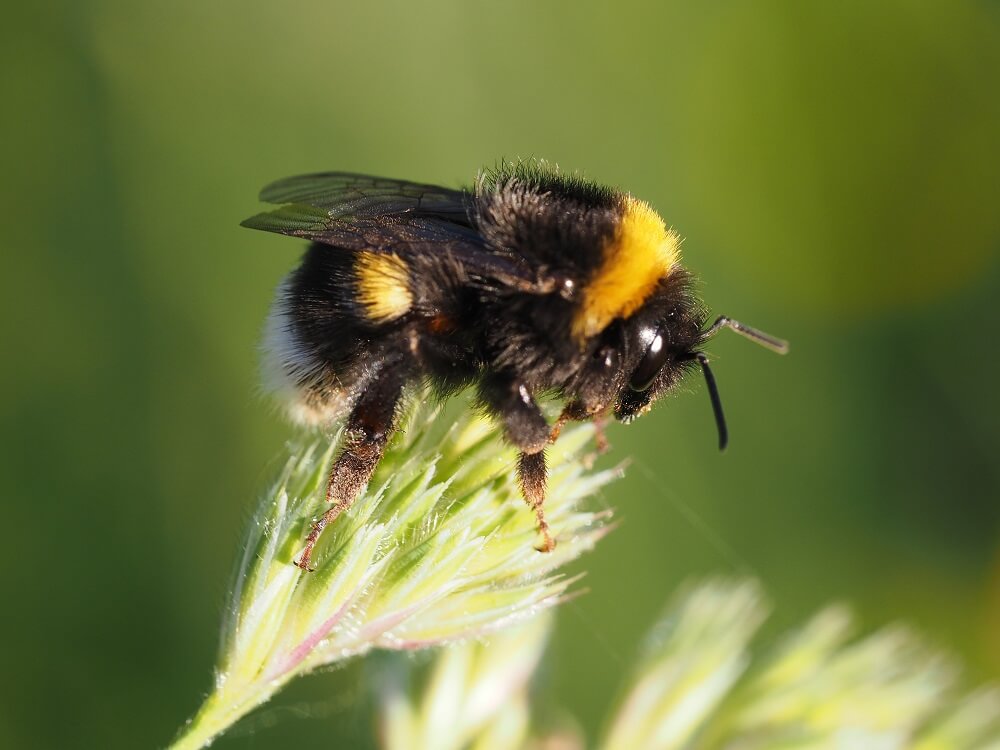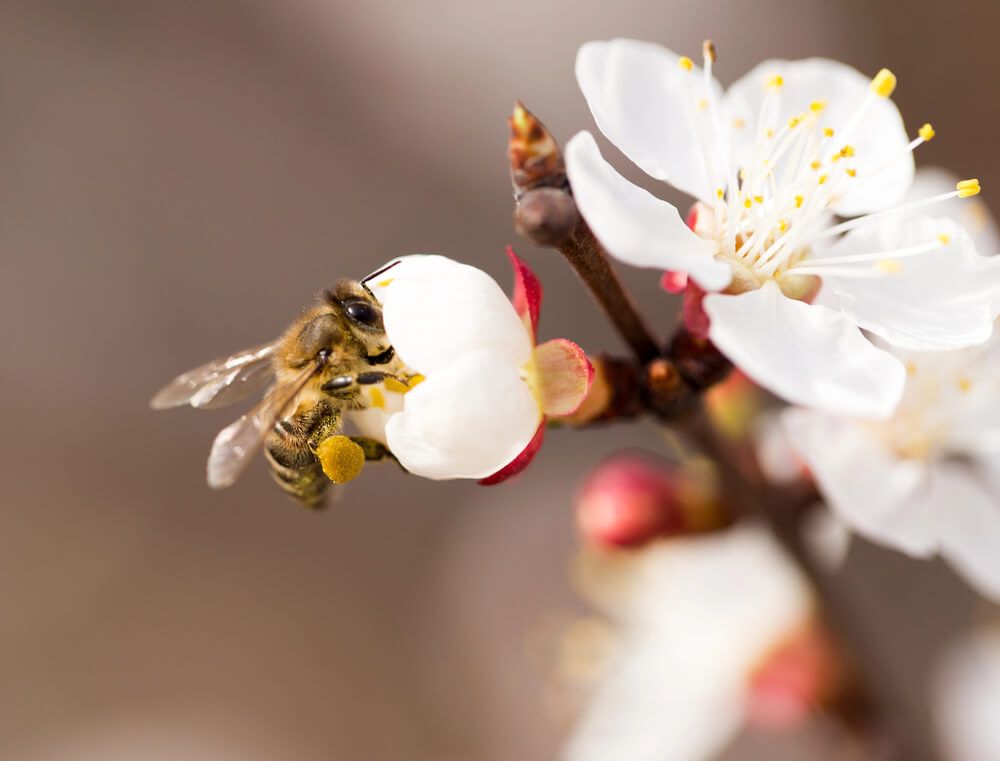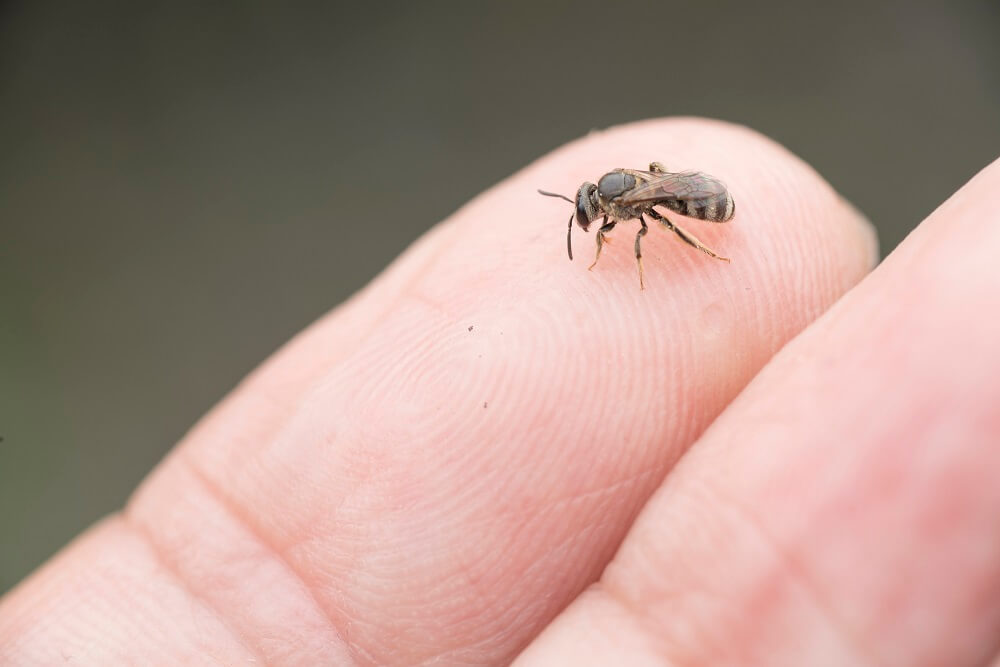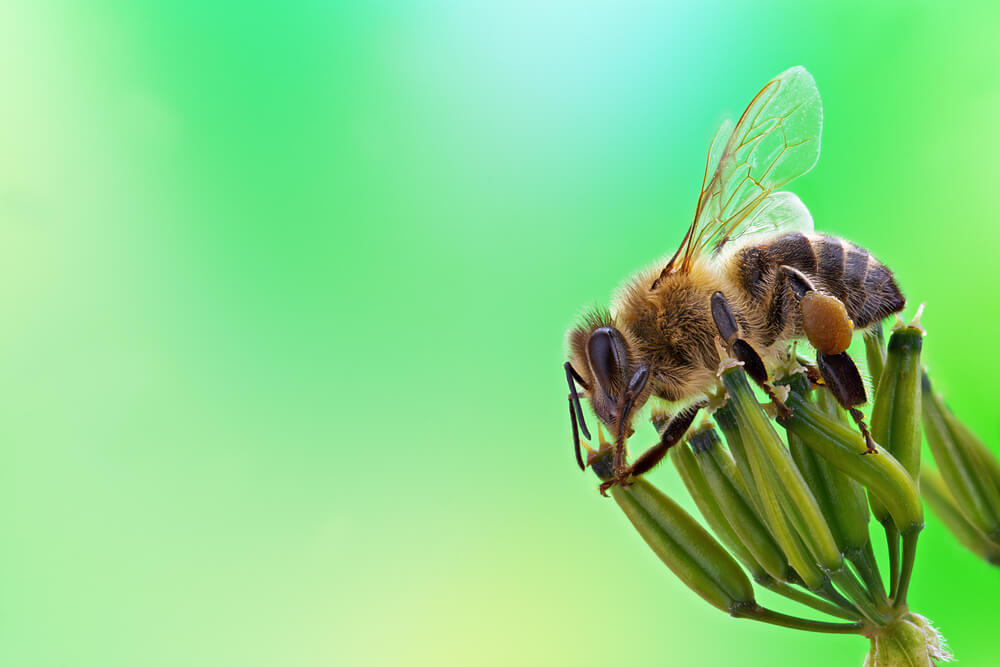When Do Bees Come Out?
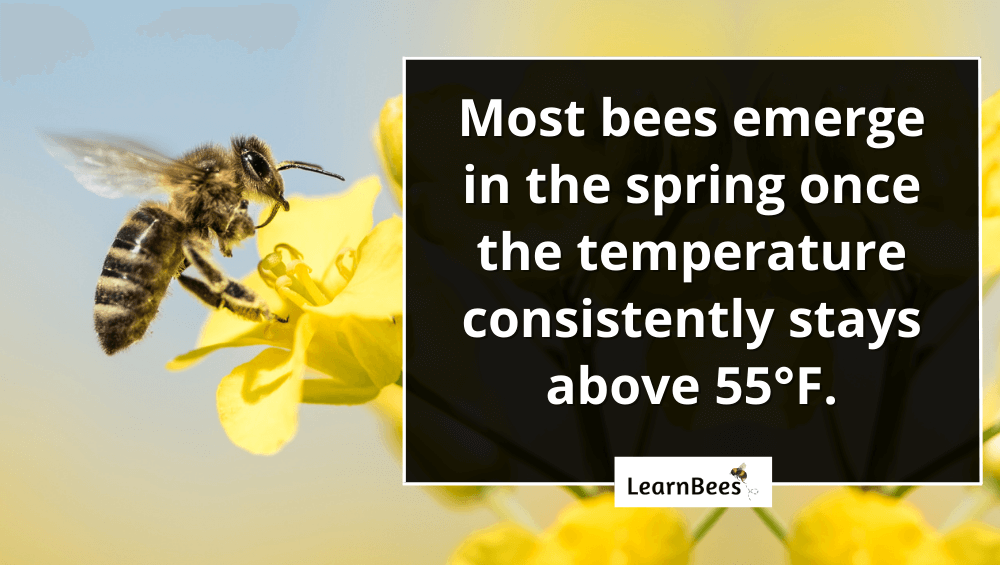
Most bees come out in the spring when temperatures are above 55°F.
At this temperature, bees can begin to fly and forage for pollen and nectar. However, different species of bees have different times for emerging. Keep in mind that there are more than 20,000 bee species.
Bumblebees, for example, can emerge in spring at slightly cooler temperatures around 50°F.
On the other hand, honeybees start stirring a lot once temperatures are above 60°F.
Now you might be wondering:
Why are bees inactive during cold weather?
A few reasons. For one, bees are cold-blooded creatures. This means their body temperature relies on external factors, such as the sun or the surrounding environment. For bees and many other insects, the cold temperature change is a matter of life and death.
To put it simply:
Bees don’t thrive in cold weather.
In contrast, most mammals maintain stable body temperatures despite environmental conditions. For example, humans have an average body temperature of 98.6°F.
Secondly, bees aren’t active in cold weather because that’s when food supplies become low.
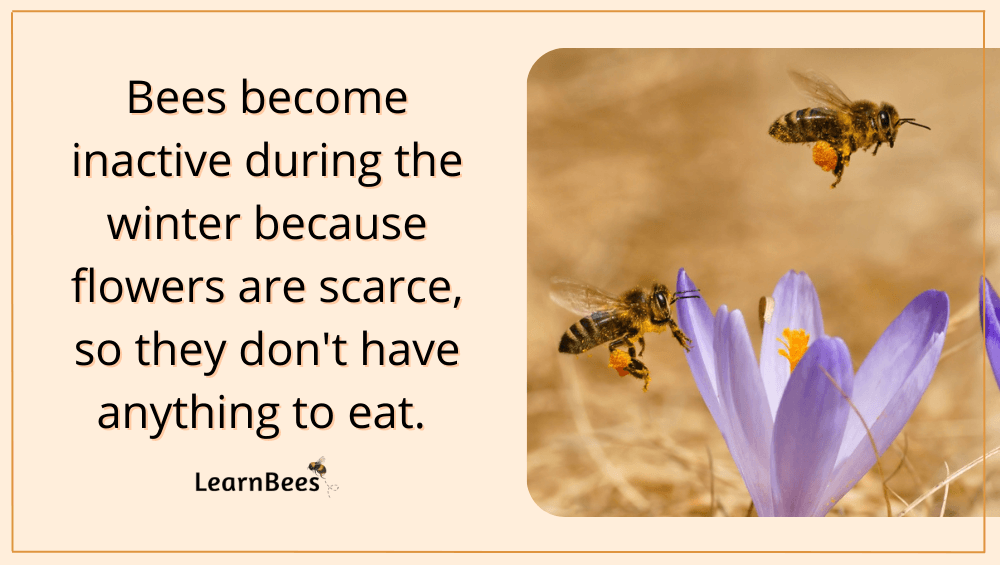
You see, bees eat nectar and pollen from flowers, which are both in short supply during the winter. The lack of food makes it difficult for bees to survive. As such, many bees hibernate to bypass the winter period completely. They wake up once food becomes more plentiful again.
How does this work?
Hibernation can vary amongst bee species. But let’s take bumblebees, for example.
Bumblebees are social bees that live in groups with other bumblebees. Every bumblebee colony has one queen that’s responsible for laying eggs. The other bumblebees are responsible for building the nest, protecting it, and collecting food.
By late fall, the bumblebee colony dies off and leaves only the queen bumblebee behind.
The queen bumblebee hibernates over the winter. She emerges in the spring to build her nests and lay eggs to start a colony.
Bumblebee queens often hibernate in small holes just beneath the ground’s surface.
But here’s the thing:
Not all bees hibernate.
Honeybees are a type of bee that doesn’t hibernate. Instead, they form a winter cluster to keep warm. A winter cluster is when honeybees huddle together to generate enough heat to keep the hive at a temperature of 95°F.
For food, honeybees depend on the honey they produced earlier in the year.
Can Bees Stay Active Year Round?
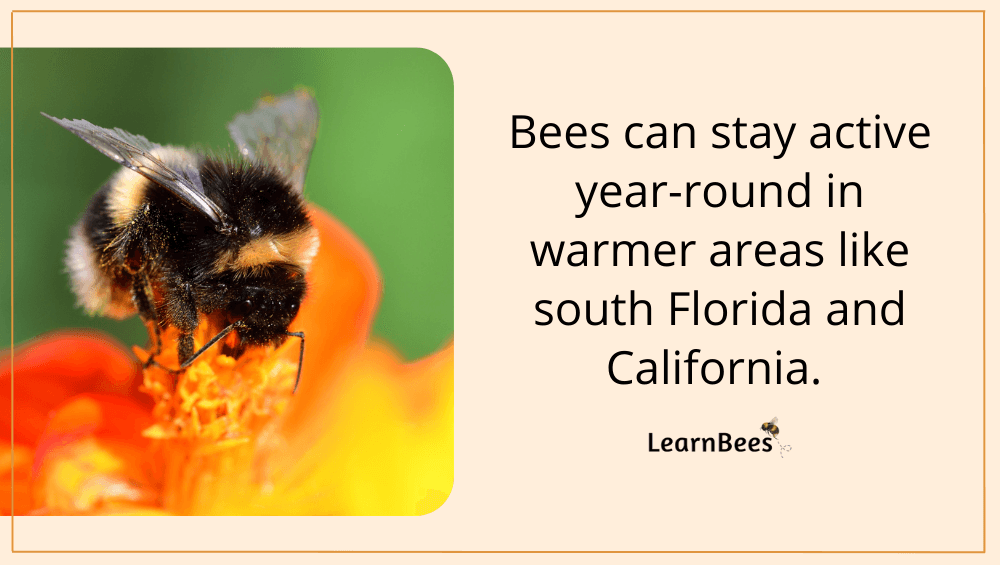
Yes, bees can remain active throughout the year in warmer climates.
For instance, ‘winter’ is a loose term in places like Florida, California, and Hawaii. The winters are mild and brief, which allows the bees to stay busy year-round. Flowers bloom regularly throughout the year, giving the bees a nectar flow at any given point.
That said, some mild climates experience frequent temperature fluctuations.
In parts of Florida, it can be 50°F one day and 75°F the next. This means bees may briefly stop laying eggs and begin the wintering process, only to be jerked into springtime-like conditions within a couple of days.
Fortunately, bees are resilient little creatures that manage these conditions well.
In cooler climates like the Northeastern United States, bees will begin overwintering by November and stay that way until April or May.
To sum it up, the answer to ‘When do bees come out?’ depends on the bee species in question and their climate.
Some bees, like bumblebees, come out in early spring, while others, like honeybees, might not emerge until mid-spring.
In general, however, most bees become active once the weather outside warms up and there is an abundance of flowers to collect nectar and pollen from.
Bees rely on pollen for their protein needs and nectar for their carbohydrate needs.
FAQs on “When Do Bees Come Out?”
- When do queen bees come out?
- When do male bees come out?
- Do bees come out in the rain?
- Can bees stay active all year round?
- What time are bees most active?
- What time of the day do bees go away?
- At what temperature do bees come out?
- At what temperature do bees become inactive?
- What time of year are bees most aggressive?
- When do bees start swarming?
- What time of year do bees nest?
- Do bees like the cold?
- What time do bees wake up?
- What time do bees go to bed?
- What month do bees start coming out?
When do queen bees come out?
Queen bees generally come out in early spring when temperatures start to warm up, and there is an abundance of flowers to collect nectar and pollen from. Once they emerge, the queens begin building their nests and laying eggs to start their colony.
With that in mind, not all bees live in social colonies. In fact, most bees are solitary creatures. This means they don’t have a queen bee; instead, each female bee is responsible for building her own nest, collecting food, and laying eggs. She is entirely independent and lives alone.
It’s estimated that over 75% of all bee species are solitary. The most common solitary bees include:
- Mason bees
- Leafcutter bees
- Sweat bees
But keep in mind:
Not all bee species hibernate like bumblebees, mason bees, and carpenter bees do.
For example, honeybees are a type of bee that doesn’t hibernate. Instead, they form a winter cluster to keep warm. A winter cluster is when honeybees huddle together to generate enough heat to keep the hive at a temperature of 95°F.
—> Go back to the FAQs on “When Do Bees Come Out?”
More to Explore:
- Do Queen Bees Eat Honey?
- Are Worker Bees Male or Female?
- Queen Bee Versus Worker Bees – How Do They Compare?
When do male bees come out?
Like other bees, male bees come out in the early spring when the weather starts to warm up, and there is an abundance of flowers for them to collect nectar and pollen from.
It’s important to mention that this varies amongst bee species. There are thousands of different bee species, including mason bees, bumblebees, leafcutter bees, and honeybees.
For example:
Male mason bees always emerge before the female mason bees. During the harsh winter months, a fully formed adult mason bee remains in its cocoon inside the nest. When temperatures warm up in early spring, the adult mason bees come out of their nests.
Here’s the thing:
Male mason bees always emerge before females because the male eggs are placed near the nest entrance. Meanwhile, the female eggs are placed in the back of the nest.
Thus, male mason bees come out first and wait for females from other nests to appear. Once the females emerge, the mating process begins, and females begin laying eggs and building new nests.
—> Go back to the FAQs on “When Do Bees Come Out?”
More to Explore:
- Do Carpenter Bees Pollinate?
- How Long Do Bumble Bees Live?
- Honeybees vs. Bumblebees: How Do They Compare?
Do bees come out in the rain?
Bees will come out during light rain showers.
However, if the rain is too heavy and the wind is rough, then bees will stay inside their nests until it passes. Bad weather deters bees because it makes it difficult for them to fly and collect food. A heavy rainstorm can make their body and wings wet, slowing them down while flying.
Additionally, large rain drops can injure a bee due to their small size, so it generally isn’t safe for bees to forage on flowers during bad weather.
Bees prefer warm, sunny weather with low to moderate winds.
—> Go back to the FAQs on “When Do Bees Come Out?”
More to Explore:
Can bees stay active all year round?
Yes, bees can remain active in certain climates all year round. For example, in southern California, bees may never hibernate or go into dormancy because the weather is suitable for them year-round. Some areas of the country never experience a proper winter like other places do.
However, in most cases, bees will become inactive during winter when it’s too cold to fly and collect food. During the winter, bees will either hibernate or enter a state of dormancy, depending on the species.
Honeybees, for instance, don’t hibernate. Instead, they become less active by remaining in their hives and forming a tight cluster to keep themselves warm. This cluster contains thousands of honeybees.
In contrast, carpenter bees are a type of bee that goes into true hibernation. This means they will hibernate in a protected area, such as a tunnel in a tree, and spend the winter in this location until it’s warm enough for them to come out again.
—> Go back to the FAQs on “When Do Bees Come Out?”
More to Explore:
- Ground Bees: Are They a Threat to Your Yard?
- Wasps vs. Honeybees: Are They Different?
- Do Bumble Bees Bite?
What time are bees most active?
It’s not uncommon for bees to work sunup to sundown during the warm months such as spring, summer, and early fall.
For the day-to-day activities, bees are typically the most active during the warmest parts of the afternoon.
—> Go back to the FAQs on “When Do Bees Come Out?”
More to Explore:
What time of the day do bees go away?
Bees will fly back to their nests as the day starts to cool down and nightfall approaches. However, this doesn’t mean the bees are active at night.
For example, honeybee colonies have a system in place where while some bees are sleeping, other bees are working. As a result, some honeybees are active at night doing duties like cleaning the hive, feeding baby bees, and making beeswax or honey.
—> Go back to the FAQs on “When Do Bees Come Out?”
More to Explore:
At what temperature do bees come out? At what temperature do bees become active?
Different bee species have different temperature thresholds for when they become active. For example, bumblebees can fly in temperatures as low as 50°F. In contrast, honeybees become more active when temperatures rise above 55°F.
In general, most bee species become active and begin foraging for food when the temperature outside is somewhere between 50-60°F. When it’s too cold, bees will stay inside their nests, either hibernating or in a state of dormancy.
—> Go back to the FAQs on “When Do Bees Come Out?”
More to Explore:
At what temperature do bees become inactive?
When temperatures outside begin to drop below 50-55°F, bees will become less active and go into hibernation or a state of dormancy. This is because flowers become scarce in the cold weather, and it becomes more difficult for bees to fly in colder temperatures.
Bees are also cold-blooded creatures, so they rely on their environment’s temperature to regulate their body temperature. When it’s too cold outside, bees will have difficulty maintaining a suitable body temperature, which can eventually lead to death.
As a result, bees become inactive during cold weather to conserve energy until the weather warms up.
—> Go back to the FAQs on “When Do Bees Come Out?”
More to Explore:
What time of year are bees most aggressive?
Despite popular belief, most bees are typically not aggressive. They leave people alone as long as their hives aren’t disturbed. So the best thing to do is to give bees plenty of space away from their nests.
That said, spring and summer are peak bee seasons, so if you encounter a bee, it’s probably during that time.
—> Go back to the FAQs on “When Do Bees Come Out?”
More to Explore:
When do bees start swarming?
Bees can technically swarm anytime in the spring, summer, or fall. However, most bees swarm during the spring or summer since that’s their peak season when their colonies become the largest.
—> Go back to the FAQs on “When Do Bees Come Out?”
More to Explore:
What time of year do bees nest?
Bees nest anytime in the spring or summer.
—> Go back to the FAQs on “When Do Bees Come Out?”
More to Explore:
Do bees like the cold?
No, bees don’t like the cold. In fact, they become less active and will go into hibernation or a state of dormancy when temperatures outside drop below 50-55°F. This is because flowers become scarce in the cold weather, and it becomes more difficult for bees to fly in colder temperatures.
—> Go back to the FAQs on “When Do Bees Come Out?”
More to Explore:
What time do bees wake up?
Bees begin to become active when the temperature outside is somewhere between 50-60°F. When temperatures warm up, the bees will be busy from sunup to sundown.
—> Go back to the FAQs on “When Do Bees Come Out?”
More to Explore:
What time do bees go to bed?
Bees will go back to their nests once nightfall approaches. However, this doesn’t mean the bees aren’t active at night. For example, honeybee colonies have a system in place where some bees are sleeping while other bees are working. As a result, some honeybees are active at night doing duties like cleaning the hive, feeding baby bees, and making honey.
—> Go back to the FAQs on “When Do Bees Come Out?”
More to Explore:
- What Do Bees Use Pollen For?
- Bees Color: 10+ Types of Colored Bees With Pictures
- Beehive on Ground: Are They a Problem?
What month do bees start coming out? When do bees come out of hibernation?
The months in which bees become active can vary depending on your climate.
Warm climates might have bees appearing as early as March, while colder climates may have to wait until April or May.
